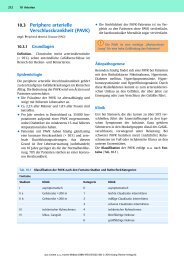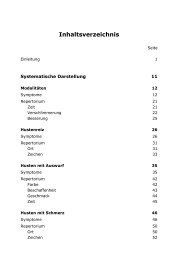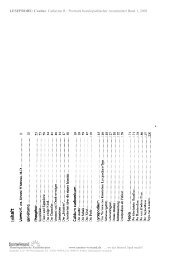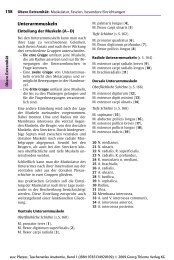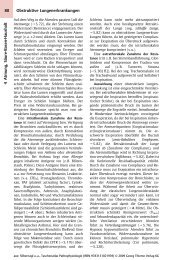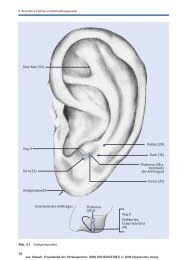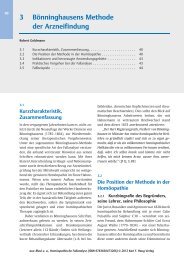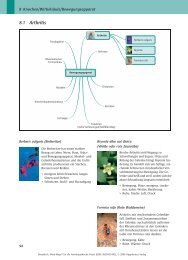alphabetical index of plant families and groups - Sunrise Versand
alphabetical index of plant families and groups - Sunrise Versand
alphabetical index of plant families and groups - Sunrise Versand
Create successful ePaper yourself
Turn your PDF publications into a flip-book with our unique Google optimized e-Paper software.
or even hot in nature. Adopting the concept <strong>of</strong> cure by opposites, Ron<br />
Teeguarden proclaims that ‘American Ginseng is thus useful for people who are<br />
hot. In other words, people who tend to have lots <strong>of</strong> energy, high metabolisms,<br />
are aggressive, have high blood pressure <strong>and</strong> have ruddy complexions can take<br />
American Ginseng for its adaptogenic benefits without fear <strong>of</strong> overheating.’<br />
One <strong>of</strong> P. ginseng’s most common side effects is the inability to sleep. Other<br />
adverse effects include dizziness, nausea, diarrhoea, euphoria, headaches, epistaxis,<br />
altered blood pressure <strong>and</strong> breast tenderness. This is a reference to the<br />
controversial ‘ginseng abuse syndrome’.<br />
Two Edged Sword<br />
‘The presentation <strong>of</strong> the mild <strong>and</strong> beneficial nature <strong>of</strong> ginseng was turned upside<br />
down about two centuries later [after its introduction to Europe in 1704]. Ginseng<br />
had become exceedingly rare <strong>and</strong> costly, <strong>and</strong>, as a result, it had become an object<br />
<strong>of</strong> abuse. Physicians <strong>and</strong> herb merchants would promise incredible results from<br />
using the rare root [which, at the time, was not cultivated <strong>and</strong> only obtained<br />
from remote forests in Northeast China <strong>and</strong> Korea]. Desperate patients <strong>and</strong> their<br />
<strong>families</strong> would seek it out <strong>and</strong> then use as much as possible in an attempt to<br />
overcome an obviously debilitating or fatal condition. Ginseng was even<br />
described as being able to bring back the dead [probably meaning that it would<br />
restore health to someone who appeared to be imminently dying].<br />
‘When some <strong>of</strong> the ailing patients died after taking ginseng, responsibility for<br />
the death might be attributed to the ginseng. Hence, ginseng became known as<br />
a potentially dangerous herb. Zhang Lu, a physician <strong>of</strong> the Qing Dynasty period,<br />
commented: “Some people look upon ginseng as poison or a sword [two-edged,<br />
able to provide help, but also to destroy] <strong>and</strong> stubbornly refuse to use it.”<br />
‘Still, its old reputation as a healer for serious conditions <strong>and</strong> as a preventer <strong>of</strong><br />
ageing <strong>and</strong> death was retained. Ginseng eventually became known to the West<br />
through the efforts <strong>of</strong> missionary doctors living in the East. The British doctors<br />
Smith <strong>and</strong> Stuart, working in China at the end <strong>of</strong> the 19th century, wrote:<br />
“Ginseng, with the Chinese, is the medicine par excellence, the dernier ressort<br />
[last resort] when all other drugs fail; reserved for the use <strong>of</strong> the Emperor <strong>and</strong> his<br />
household <strong>and</strong> conferred by Imperial favour upon high <strong>and</strong> useful <strong>of</strong>ficials<br />
whenever they have a serious breakdown that does not yield to ordinary treatment,<br />
<strong>and</strong> which threatens to put a period to their lives <strong>and</strong> usefulness. . . . The<br />
ordinary ginseng <strong>of</strong> the markets has been studied <strong>and</strong> has not been found to<br />
possess any important medicinal properties. But the Chinese describe cases in<br />
which the sick have been practically in articulo mortis, when upon the administration<br />
<strong>of</strong> ginseng they were sufficiently restored to transact final items <strong>of</strong><br />
business. . . . It is prescribed in nearly every kind <strong>of</strong> disease <strong>of</strong> a severe character,<br />
with few exceptions, but with many reservations as to the stage <strong>of</strong> the disease in<br />
which it may be administered with the greatest benefit <strong>and</strong> safety.” ’ [Dharman<strong>and</strong>a<br />
2000]<br />
© Saltire Books Ltd<br />
502 Family ARALIACEAE



